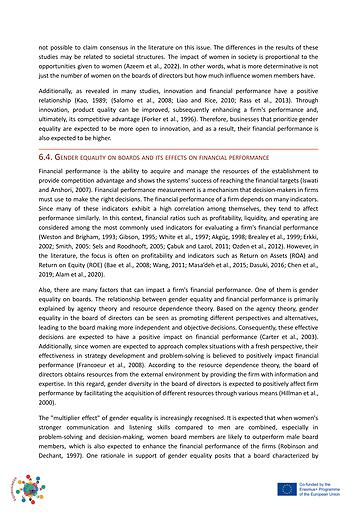Equbusiness book VERSION 28SEPT2023 - Flipbook - Page 84

-
When the board consists of 6 to 8 members, each sex should be represented by a minimum of three
members.
-
For boards with 9 or more members, each sex must be represented by at least 40% of the total board
members.
While the term "40%" is commonly used, it is important to highlight that the precise quota is contingent upon the
number of board members, with exceptions for members elected by employees.
In addition to the specified scope and quota percentage, the consequences for corporations in Norway found
non-compliant with gender diversity quotas extend to the prospect of dissolution. While § 6-11 of the quota rule
itself does not prescribe any sanction, the legal framework provides for sanctions under § 16-15/16. Upon
identified non-compliance, corporations are granted a statutory notice period of four weeks to rectify their
adherence to the gender quota, as stipulated in § 16-15/16.
At the expiration of this notice period, the matter is subject to judicial review, as contemplated by § 6-11.
Remarkably, the sole judicial recourse available in instances of non-compliance is the severe measure of
dissolution. The legal framework explicitly restricts the court's prerogative, unequivocally stating that no
alternative remedy beyond dissolution may be prescribed. Consequently, the court is prohibited from
deliberating on alternative corrective measures, such as the appointment of a qualified candidate or any other
intervention in the composition of the corporate board.
Contrary to § 16-15/16 of the Norwegian Limited Liability Company Act, the Norwegian Ministry of Justice
advised that the court cannot decide on dissolution (Sjåfjell, 2015). However, the legal landscape offers no explicit
guidance on alternative remedies in such instances. Furthermore, as of the present, no precedent or decision has
been issued by the courts that addresses the gender quota issue in Norway, leaving the matter without a
definitive resolution.
7.4.1.2. FRANCE
France is another example of employing gender quotas to cultivate gender balance within corporate boards
(Rosenblum & Roithmayr, 2015; Chandler, 2016; Winters& Jacops-Sharma, 2016; Mensi-Klarbach et al., 2017;
Zenou et al, 2017; Kang et al, 2022). The regulatory framework governing gender quotas for corporate boards was
incorporated into the corporate governance practices for listed companies in 2010. The legislative amendment,
enacted to foster gender diversity in corporate boards, was accompanied by the rationale of strengthening the
presence of women in corporate boards. The primary aim is articulated as achieving a gender-diverse corporate
board with a balanced representation of both men and women as active members (Raphaele François-Poncet et
al., 2011).
According to the amendment, French law mandates that women must constitute a minimum of 40% of the board
of directors members. The amendment, implemented in 2011, allowed a transitional period of six years for
corporations to take measures to comply with the stipulated gender quota (Rosenblum & Roithmayr, 2015; Zenou
et al, 2017). Notably, the French legislators, in contrast to Norwegian regulations, appear to be emphasizing a
preference for promoting women's representation to achieve gender diversity. For instance, a corporate board in
France with four members may be structured with three women and one man. In contrast, under Norwegian
laws, employing the same percentage for corporate board gender quotas would be illegal. It is mandated that
even men should be represented at a minimum of 40%. Consequently, a corporate board with nine women and
one man would be non-compliant with Norwegian regulations. However, both French and Norwegian laws share
similarities. In accordance with French law, members elected by employees are excluded from the calculation of
the 40% quota, granting employees the freedom of selection unconstrained by the quota. Another notable aspect
of the French quota is the restriction that the difference in the number of men and women cannot exceed two












